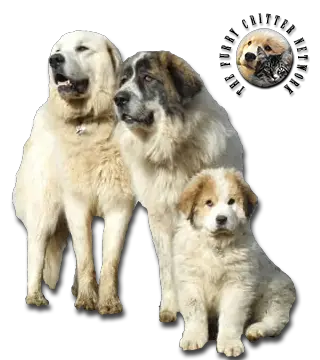Breed Standard
Head: Size in proportion to body. Slightly domed skull. Stop not pronounced. Broad muzzle tapering toward the nose. Black, very slightly drooping lips.
Ears: Small and triangular with rounded tips, hanging flat against the head.
Eyes: Fairly small. Dark amber color. Black rims.
Body: Powerful. Strong, moderately short neck. Deep, broad brisket. Ribs slightly sprung. Belly slightly tucked up. Croup slightly sloped. Broad, straight, level back.
Tail: Fairly long and bushy (plume). Carried low at rest and carried over the back making a wheel when alert.
Hair: Long, flat, resistant, and thick. Longer on the tail, thighs, and neck where it may be slightly wavy. Thick, wooly undercoat.
Coat: White with or without gray spots (badger coat) or pale yellow or orange on the head, ears, and root of the tail. Badger coat is preferred. A few body spots are permissible.
Size: Dog: 70 to 80 cm (27.5-31.5 in).Bitch: 65 to 72 cm (25.5-28 in).
Weight: Dog: approx. 60 kg (132.5 lb).Bitch: approx. 45 kg (99 lb).
History
Like many Molossians, the Great Pyrenees’ distant ancestor may be Tibetan Mastiff, which was introduced in Europe during Asian invasions. Identified as early as the 12th century, the Great Pyrenees protected the shepherd and his flock from wolves and bears, guarded homes and castles, and even sat in the royal court of Louis XIV. The Argeles and Cauterets clubs, founded in 1907, established the first standard for this breed. This standard was officially accepted in the 1960s. The Great Pyrenees is one of the few French breeds that is common outside of France. The breed is particularly popular in the United States and Japan.
With the extirpation of wolves from the Pyrenees, the popularity of the breed declined and by the beginning of the 20th century it was on the verge of extinction. Local shepherds sold pups to eager tourists and it is from these pups the breed found its way to Britain and several were registered with The Kennel Club at the beginning of the century, although British interest in the large breed declined during the First World War. French aristocrat and dog authority Bernard Senac-Lagrange is credited with saving the breed from extinction at the beginning of the 20th century, touring the mountains to collect the finest specimens available to form a breeding base. Senac-Lagrange established the first breed club, the Réunion des Amateurs de Chiens Pyrenees, and drew up the first breed standard for the breed in 1923; he also registered the breed as the Chien de Montagne des Pyrenees with the Societe Centrale Canine in the same year. In 1946 the Real Sociedad Canina de Espana recognized the large white livestock guardians on the Spanish side of the Pyrenees as the Pyrenean Mastiff with a slightly different breed standard.
In the early 1930s, the Pyrenean Mountain Dog was imported into North America where it is known as the Great Pyrenees. The breed became a favorite in the show ring in both Canada and the United States. In 1935, the American Kennel Club adopted a new breed standard that had a number of deviations from the French original that would not be permitted in France. This standard promoted the exaggeration of certain physical features at the expense of functional form and was later adopted by Britain's Kennel Club. To combat the deterioration of the breed's show lines in their country, in 2011 the British Pyrenean Mountain Dog breed club released a brochure with instructions for show judges not to reward glamorous, heavy-bodied, short-muzzled examples of the breed over lean and muscular examples with weatherproof coats capable of performing their original role in high mountainous regions.
Behavior
In nature, the Great Pyrenees is confident, gentle (especially with children), and affectionate. While territorial and protective of its flock or family when necessary, its general demeanor is of composure and patience and loyalty. It is a strong willed, independent and reserved breed. It is also attentive, quite fearless and loyal to its duties. The Great Pyrenees' size makes it an imposing guardian. A dog of this breed will patrol its perimeter and may wander away if left off its leash in an unenclosed space. The Great Pyrenees protects its flock by barking, and being nocturnal, tends to bark at night unless trained against such behavior.
The Great Pyrenees can be slow to learn new commands, slow to obey, and somewhat stubborn to train. Despite this relative stubbornness, it is quite unusual for the Great Pyrenees to become aggressive or turn on its master. It is wary of strangers if the person is not allowed in the house, but will settle down if the owner of the dog seems comfortable with the stranger. This dog was originally bred to be a livestock guard dog, and can still be found doing that job on farms and ranches.
This dog is not suited to city living. He needs exercise and room to run, or he will develop behavioral problems. He does not like to be shut in. Brushing three times per week and bathing several times per year is required.
Function
Herder, Guard Dog, Pet.
Health
Great Pyrenees are usually very healthy, but may suffer from hip dysplasia, hot spot skin conditions, and epilepsy. Other health concerns include entropion (inverted eyelids), luxating patellas, and bloat (gastric torsion; twisted stomach). Bloat is a health issue to most dogs, being the second largest killer of dogs other than cancer, but Great Pyrenees can be particularly susceptible to it because of their deep chests.






